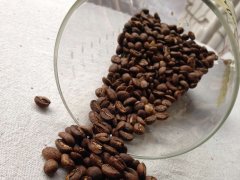Factors affecting the baking degree of coffee beans during roasting process

The process of fried beans is the main process of heating raw beans and developing the aroma and taste of coffee. The aroma and taste emitted are determined by the original characteristics of each kind of raw bean. The depth of fried beans depends on the type of raw beans, market demand or the way they are cooked. What kind of baking machine controls the depth of fried beans. Even though the chemical and physical components of various raw beans are different, the principles of these ingredients are similar even if they are slightly different in the process of stir-frying.
Baking is a process in which raw beans filled with water are exposed to rapid heating to 400 degrees Fahrenheit (200 degrees Celsius). At this temperature, the interior of the coffee bean produces high temperature decomposition. A brief exothermic process took place. The temperature of coffee beans increased to 392 to 410 degrees Fahrenheit (200 to 210 degrees Celsius), while coffee beans lost 4 to 6 percent of their weight. Raw beans have 12% moisture. From then on, the process of fried beans will lose a total of 16% to 18% moisture. In the process of baking, the more moisture is lost, the darker the color of coffee beans is. The color of coffee beans is also formed in the process of rapid weight loss. Most of the sugar will change and the coffee beans will continue to swell (about twice the size of the original beans) and cracks will appear on the surface at the same time.
At the beginning of high temperature decomposition, about 7.5% of chlorophyll in raw beans decreased slightly, while only about 4% of fried beans were left. The PH value of raw beans was about 6.0. at the beginning of high temperature decomposition, it gradually decreased to 5.5, and then decreased to 4.9 in lightly fried beans. Basically, this process is a dry distillation process that uses thermal decomposition of organic matter in raw beans. The cessation of fried beans when they reach the desired taste is the same as the desired degree of high temperature decomposition and weight loss. The time to stop the stir-fried beans is determined by the depth of the beans in the baking, and also by the temperature of the coffee beans under the temperature control system of the roaster. The key point is that the high-temperature decomposition of sugar and the degree of caramelization determine the ideal taste and aroma of coffee.
There are two speeds of weightlessness in the baking process. The first is slow, which is caused by the evaporation of water in the beans. The second is rapid high temperature decomposition. When the rate of loss of moisture increases, the carbon dioxide in beans increases rapidly. The timing of this transition occurs at the beginning of high temperature decomposition, that is, about 365 degrees Fahrenheit (185 degrees Celsius) or about 10% water loss from raw beans. Although the release rate of 2% of carbon dioxide is calculated, it is possible to release 1% of carbon dioxide in the delicious shallow fried beans. These common fried beans mentioned above are very similar in all kinds of coffee, even if they are very different Robustas (Robbins beans) such as Java coffee. However, these similarities should not be confused with the original size, species, water content, and other factors that affect the development of the ideal taste of each batch of beans.
Factors affecting the depth of baking
Lightly fried beans contain more acid, so they are suitable for areas where alkaline water is used. Lower-grade coffee beans have the characteristics of poor taste, which can be easily revealed by stir-frying. So usually we use deep stir-fry to drive away the bad volatiles in the beans. From the previous discussion, mixing beans that have already been baked has many benefits. Habit and local people's favorite taste usually determine the depth of fried beans. In cities, fried beans are usually deeper than usual, just like what we call "urban stir-frying". This kind of stir-frying is shallower than French frying and does not have any characteristics of overcharge. it is often used by coffee makers to prepare instant coffee. Since there are more carbohydrates made into aqueous solution in the factory filtration process than brewing coffee at home, the taste of more carbohydrates must be comprehensively balanced by deep frying.
There is a certain relationship between the color of roasted coffee beans and the percentage of roasted weightlessness. Light to medium stir-fry like cinnamon, when it first entered the range of delicious coffee, the weight loss was about 14%. Baking that is dark brown but not all black will lose about 15.5% of its weight. The deepest roasting with a slightly black tint of brown will lose about 17% of its weight, which is the most commonly used and deepest stir-frying method in the United States. However, the stir-frying of individual products, such as French-fried coffee, is very dark brown and has oil on the surface of the beans, with about 18% weightlessness. The Italian style of frying is very dark brown, with a weightlessness of about 20%. In all cases, let's assume that raw beans are about 12% moisture.
The amount of water-soluble matter in different coffees changes at 212 degrees Fahrenheit (100 degrees Celsius), but deep frying reduces the production of extracts. For example, in medium frying, the degree of weightlessness of 15% will produce 23% of the extracted solution. However, when the same coffee beans are fried to 18% weightlessness, only 21% of the extracted solution will be produced. The hydrolysates of interest to instant coffee manufacturers will also be reduced in deep speculation. By the same token, the range of hydrolyzed solutes can be 25% to 22%. In other words, the sum of all reduced extracts and hydrolyzed solutes is 48% to 43%. This has a great impact on the real solution that can be obtained by cooking coffee. Cooking lightly fried beans produces 38% of the solution, while cooking lightly fried beans produces 35% of the solution. Deep-fried beans will have greater damage to the cell wall and powerful structure, so they have better compressibility. For this reason, deep fried beans under compression and more pressure will leak from the bottom of the coffee filter more often than shallow fried beans. Deep fried beans are also fragile, and there are more fine powders during grinding. These finer powders also put more pressure on each drop of coffee or make the extraction more resistant. Although the above coffee weightlessness is important, it is less measurable. It is possible to identify eight colors from the lightest to the darkest with the naked eye. These speculation methods are as follows:
Light Roast extremely shallow baking
Cinnamon Roast cinnamon / shallow baking
Baking in Medium Roast
Medium and deep baking in High Roast
City Roast deep baking
Full City Roast very deep baking
French Roast French baking
Italian Roast semantic baking
When roasting with a mixture of different coffee or different coffee beans, and want to use the depth of roasting to control the ideal taste, you need to test frequently. Mixed shallow fried beans show different special tastes than single deep fried beans. Deep-fried beans release more fatty acids and their extracts, which can make coffee have more coffee flavor. When coffee beans are removed from the roaster, cooling with water will increase the moisture of the coffee beans and deepen the color on the surface of the coffee beans, so dry coffee beans can not be compared with each other.
Three baking processes: drying, high temperature decomposition and cooling
Newly imported coffee beans usually contain about 12% moisture, and when the coffee beans are roasted at a high baking temperature from 500 to 800 degrees Fahrenheit, when the coffee beans heat up, the water evaporates. Most of the moisture is released in the first few minutes of the baking process, although the baking time in the United States is usually about 15 minutes, which may be 5 minutes or as long as an hour. After 8 minutes, the temperature of the beans will rise to 300 degrees Fahrenheit and the beans will lose green, turn yellow and begin to turn brown. Between 260 and 370 degrees Fahrenheit, between 11 and 12 minutes, more water will slowly dissipate, coffee beans reach 390 degrees Fahrenheit, coffee becomes light brown. At 14 minutes, the temperature of the beans reaches 410 degrees Fahrenheit and the color changes to a moderate brown color. At 16 minutes, the temperature of the beans reaches 440 degrees Fahrenheit, and the color turns dark brown, which is almost equivalent to French baking. If you bake one more minute, the temperature will exceed 450 degrees Fahrenheit and turn into Italian and dark brown beans at 465 degrees Fahrenheit and 20% weightlessness.
In fact, the time control, temperature and color changes will be based on the method of fried beans, cycle period, the type of beans, the original moisture content, the speed of heating. And so on, rather than a universal description of the whole process. In all cases of baking, what really matters is that a large amount of heat is released from coffee beans at 400 degrees Fahrenheit, which is called high temperature decomposition or chemical decomposition of caramel. Sivetz invented the method of temperature and time measurement at the end of 1974. in June 1975, the A.S.I.C conference in Hamburg demonstrated that heat release is measurable and directly related to the baking quality of raw beans, that is, beans grown at the highest latitudes and the most fragrant beans release the most heat, the beans at lower latitudes are gently washed, releasing less heat, and the beans at the lowest latitudes are not released.
High temperature decomposition produces acetaldehyde and other attractive coffee aromas, which appear and maintain for a short time. High temperature decomposition determines how long the coffee taste lasts. That is, how deep we are allowed to roast coffee, some of the chemicals volatilized by coffee under high temperature decomposition are carbon dioxide, acetaldehyde, ketone, ether, acetic acid, methanol, vegetable oil, water vapor, glycerin. The particularly bad smell after baking is sour, and spicy and choking. The coffee roasting process usually takes 7 minutes in a continuous roaster and 12 to 15 minutes in a 4-bag roaster. When the baking time is more than half an hour, the coffee beans will have a light baking flavor rather than a strong aroma. The baking process is usually accompanied by a crisp explosion and lampblack formed mostly by blue water vapor. As soon as you get the ideal coffee color, the coffee beans must be poured out of the extremely hot fire immediately, and use the surrounding air and spray to cool it quickly and correctly. When you cool the coffee beans, most of the water will evaporate, and even if you spray a small amount of water mist, almost no water will be absorbed by the coffee beans. Cooled beans will stop the decomposition of high temperature. If you maintain the high temperature of the beans, the aroma will be much lower.
Important Notice :
前街咖啡 FrontStreet Coffee has moved to new addredd:
FrontStreet Coffee Address: 315,Donghua East Road,GuangZhou
Tel:020 38364473
- Prev

ILLY E.S.E system (EASY SERVING ESPRESSO)
E.S.E E.S.E (EASY SERVING ESPRESSO) is a new system developed to make espresso coffee drinks more convenient and easy to use. It was designed and patented by illy Coffee Company more than a decade ago. With the help of the E.S.E standard, you can enjoy the pure taste of high-quality espresso at home, at work, anywhere.
- Next

Coffee roaster related terms explain baking knowledge
\Afterburner A device that uses a high-energy burner to reburn the smoke produced by a coffee roaster to eliminate smoke. At the same time, it can reduce odor. A stainless steel basket with silver skin for Fuji Jia mechanism dust collector. Can accept larger quantities of silver than standard. A transformer is a device that converts electrical power into variable voltage, variable frequency, controllable, stable, and economical.
Related
- Beginners will see the "Coffee pull flower" guide!
- What is the difference between ice blog purified milk and ordinary milk coffee?
- Why is the Philippines the largest producer of crops in Liberia?
- For coffee extraction, should the fine powder be retained?
- How does extracted espresso fill pressed powder? How much strength does it take to press the powder?
- How to make jasmine cold extract coffee? Is the jasmine + latte good?
- Will this little toy really make the coffee taste better? How does Lily Drip affect coffee extraction?
- Will the action of slapping the filter cup also affect coffee extraction?
- What's the difference between powder-to-water ratio and powder-to-liquid ratio?
- What is the Ethiopian local species? What does it have to do with Heirloom native species?

